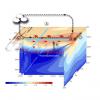Figure: Coefficient of variability (relative magnitude of the standard deviation to the average value) of SST and OMT during 1993–2017 (Courtesy: SCIENTIFIC REPORTS | (2018) 8:12092 | DOI:10.1038/s41598-018-30552-0).
Science Highlights
Please have a look at the Guidelines for Science Highlights
The Early Career Scientists Symposium was held alongside the 2016 CLIVAR Open Science Conference in Qingdao, hosted by the First Institute of Oceanography. The Symposium aimed to capture the ideas of early career researchers on pressing science priorities, immediate challenges, and emerging opportunities to help guide the future evolution of CLIVAR.
Dynamical processes in the atmosphere and ocean are central to determining the large-scale drivers of regional climate change, yet their predictive understanding is poor.
Under the 2015 Paris Agreement, nations agreed to limit global mean warming to 2°C, while also working toward the more ambitious goal of limiting warming to 1.5°C. However, current pledges to support the Paris Agreement would only limit global warming to 3°C. Would meeting the Paris temperature goals be sufficient to avoid an ice-free Arctic?
Meeting report of the International WCRP/IOC Conference on Regional Sea Level Rise and Its Impacts has been published in EOS on 05 January 2018.
Coastal zones are especially in need of climate services for adaptation, as they are increasingly threatened by sea level rise and its impacts. An important component of these services will be sea level scenarios and projections aligned to the needs of users.
A recent study indicates a robust reduction of the Indian Winter Monsoon wind intensity over the Arabian Sea by the end of the 21st century in all the 27 analysed CMIP5 models (a reduction of 6.5% for Representative Concentration Pathways (RCP) 8.5 and 3.5% for RCP4.5, on an average), which is not yet detectable in observations.
This article will show the mechanisms underlying recent decadal changes in subpolar North Atlantic Ocean (SPNA) heat content, with results implying that predictability of SPNA decadal changes is intimately tied to the predictability of the overlying atmosphere.
Sea surface temperatures that are too warm in the eastern tropical Atlantic and Pacific oceans have long stymied coupled climate model depictions of our planet.
While sea surface temperature warming was observed in most of the Atlantic and Indian Oceans, and the Western Pacific Ocean, the Central Tropical and the Eastern Pacific Ocean exhibited a cooling trend.
Given the energy accumulation in the climate system under increased greenhouse forcing, why hasn't the Southern Ocean warmed?
A new ocean ‘reanalysis’ shows, although there are uncertainties over what might happen in the short term, the longer-term view is that a weakening of the circulation in the 21st century is still very likely as a result of increasing greenhouse gases.
ENSO's response to greenhouse warming has challenged scientists for decades, despite model agreement on projected mean state changes. Recent studies have provided new insights into the elusive links between ENSO and Pacific climate mean-state changes.
The influence on ENSO's life cycle via equatorward WBC transport, the longevity of SST anomalies and strong advection transport of warm water by the Kuroshio Current, the considerable impact on Asian Monsoon via anomalous heat content exerted by the North Pacific WBCs, all have substantial climate impacts locally and globally.
Highlight of a recent paper by Newman et al. (2016), The Pacific decadal oscillation, revisited, Journal of Climate, in press.
























